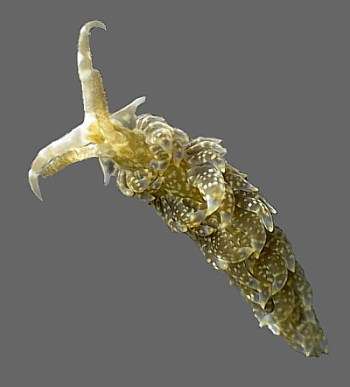
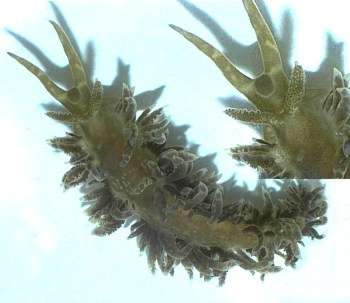
Spurilla major
(Eliot, 1903)
Order: NUDIBRANCHIA
Suborder: AEOLIDINA
Family: Aeolidiidae
DISTRIBUTION
Tropical Indo-West Pacific
PHOTO
UPPER: Fumba, Zanzibar, Tanzania. August 1971, 33mm long.
LOWER: North Reef, Dar es Salaam, Tanzania. September 1973, 45mm long. NOTE the cerata in lower animal proportionally much smaller. The ceratal size can change very quickly and apparently reflects changes in the physical well-being or physiology of the animal. PHOTOS: Bill Rudman.
Background colour is brown or brownish-green with a pattern of light, sometimes whitish patches over cerata and body. Also a distinctive pattern of bands on the head. The background colour is caused by the contents of fine branches of the digestive gland which ramify throughout the body wall. In some animals there are traces of a blue subapical band and a yellow tip to the cerata, and Eliot describes a variety ornata with a bright blue submarginal band and Gosliner (1979) reports the same colour form from Hawaii. Baeolidia major amakusana Baba, 1937 from Japan, is almost certainly a synonym. Spurilla major probably keeps zooxanthellae alive in its body. See Solar powered Sea Slug page.
See Carol Buchanan's message for a photo of an animal with intense blue markings.
References:
•Baba, K (1937) Opisthobranchia of Japan (II). J. Dept. Agric. Kyushu Imp. Univ. 5(7): 289-344. (Pls.1-2)
•Edmunds, M (1969) Opisthobranchiate Mollusca from Tanzania I. Eolidacea (Eubranchidae and Aeolidiidae). Proceedings of the Malacological Society of London 38: 451-469.
•Gosliner, T.M. (1979) The systematics of the Aeolidiacea (Nudibranchia: Mollusca) of the Hawaiian Islands, with descriptions of two new species. Pacific Science 33(1): 37-77.
•Rudman, W.B. (1982) The taxonomy and biology of further aeolidacean and arminacean nudibranch molluscs with symbiotic zooxanthellae. Zoological Journal of the Linnean Society, 74: 147-196.
Rudman, W.B., 2000 (April 14) Spurilla major (Eliot, 1903) . [In] Sea Slug Forum. Australian Museum, Sydney. Available from http://www.seaslugforum.net/find/spurmajo
Related messages
Spurilla major from Korea
March 25, 2008
From: Dong Bum Koh
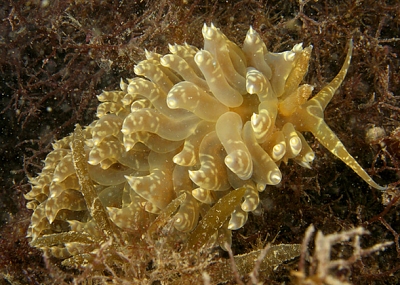
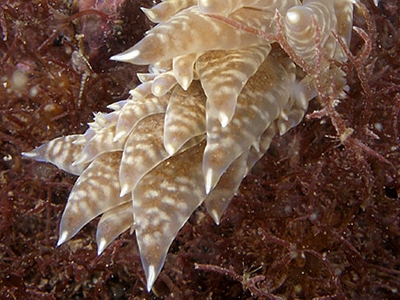
Dear Bill,
May I introduce a seaslug from Korea. It is the first time I have seen it here and I suspect it is Spurilla major.
It was taken on the southern coast of the Korean penninsula.
Locality: Tong Young City, -14 m, Kyung Nam Prov., South Sea of Korea, 20 Oct. 2007, Sea weed. Length: Approx. 30 mm. Photographer: Jeong Guwon Park.
Best regards,
Dong Bum Koh
drkoh@seasee.co.kr
D. B. Koh, 2008 (Mar 25) Spurilla major from Korea. [Message in] Sea Slug Forum. Australian Museum, Sydney. Available from http://www.seaslugforum.net/find/21065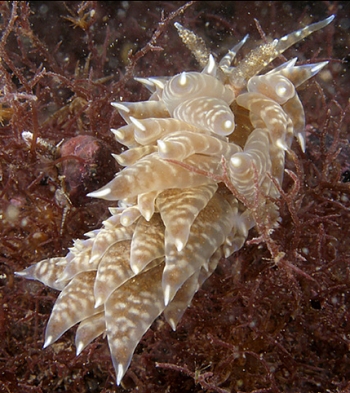
Dear Koh,
I a pretty sure it is Spurilla major, which is quite variable in colour. In the close-up photo, the brown speckling are clusters of zooxanthellae which the animal has got from the sea anemones it feed on. Another clue that it is from the family Aeolidiidae are the large white cnidosacs at the tip of each ceras. In this family the cnidosacs appear much loinger and often more slender than in other aeolids, where they are often more inflated and almost spherical in shape.
Best wishes,
Bill Rudman
Spurilla major from Eilat, the Red Sea
March 7, 2008
From: Matan Ninio
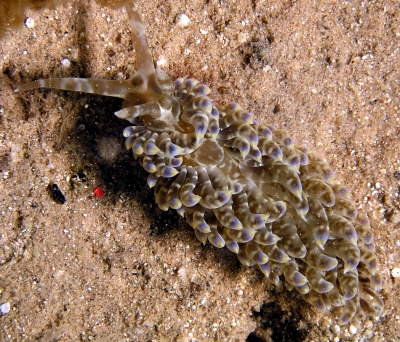
Dear Bill,
attached are some pictures taken in Eilat. The color form seems to be mid-way between the "blue" and the "brown" forms of Spurilla major on your site. There have been several other reports of this animal from our waters, and from my memory I think this is the typical color form.
This specific animal was moving quite fast on some sand near coral. We had been delighted to see it, and consider it a gift from Neptune - we had been on the way back from a cleaning dive, loaded with as much trash as we could carry (including a full size drum).
Locality: Northen Dekel/southen Electric beach, Eilat, Israel, Red Sea.
Depth: 5 m. Length: 45 mm. 24 April 2005. near a coral head. Photographer: Elad Halevi
Matan Ninio
matan@forumhasofiot.yam.dive.ninio.org
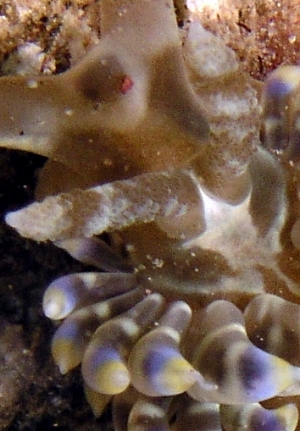
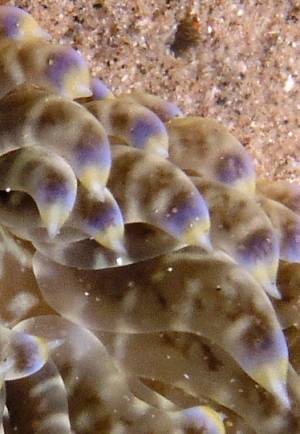
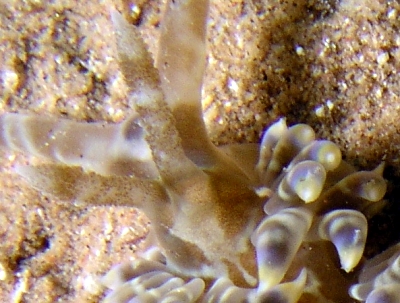
Dear Matan,
Firstly sorry it has taken so long to post this message, I found it when I was preparing the recent interesting report of this species from Turkey [#21174].
I would agree that this is the more usual colour form - or at least the colour form when the animal has been eating anemone's containing zooxanthellae. The brown specks and markings you can see in the close-ups of the rhinophores and cerata are clusters of the zooxanthellae in branches of the digestive gland.
Best wishes,
Bill Rudman
Re: Spurilla major from Turkey
March 7, 2008
From: M. Baki Yokes
Concerning message #21174:
Dear Tom and Bill,
Two years ago I have seen a specimen of this species in a laboratory aquarium at Michmoret (Israel, Mediterranean coast), which was collected off the university campus by the Ami Schlesinger from Tel Aviv University. The colour pattern of that specimen was exactly the same, but the rhinophores were much more like two thick brushes. I don't remember now which anemone it was feeding on, but, it showed the same kind of feeding behaviour as you reported on the Spurilla australis Fact Sheet. It seems that it took two years for it to cross the Levantine basin.
Best regards
Baki
bakiyokes@turk.net
Yokes, M.B., 2008 (Mar 7) Re: Spurilla major from Turkey. [Message in] Sea Slug Forum. Australian Museum, Sydney. Available from http://www.seaslugforum.net/find/21430Thanks Baki,
Best wishes,
Bill Rudman
Spurilla major from Turkey
March 6, 2008
From: tom turk
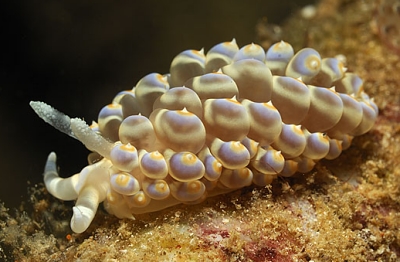
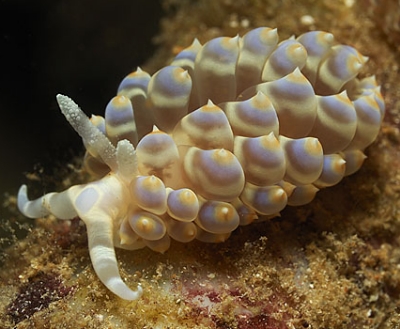
Dear Bill,
I am sending you several photos of five sea slug species photographed along the coast of Turkey near the town of Kas. I believe that at least three species are actually Indopacific (lesepsian immigrants ) in the Mediterranean Sea. I have tentatively identified three of them, for the other two I have no idea. I appreciate your help in this matter.
Locality: Kas, 25 m, Turkey, Mediterranean, end of October 2007, wreck on sandy bottom near sea anemone Alicia mirabilis. Length: 4 cm. Photographer: borut furlan.
Best regards,
Tom Turk
tom.turk@bf.uni-lj.si
Turk, T., 2008 (Mar 6) Spurilla major from Turkey. [Message in] Sea Slug Forum. Australian Museum, Sydney. Available from http://www.seaslugforum.net/find/21174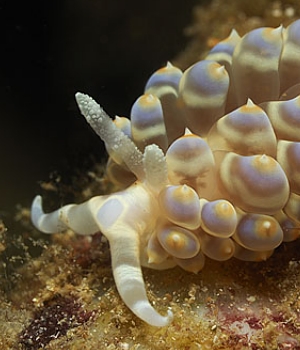
Dear Tom,
This is a member of the Aeolidiidae so its closeness to a sea anemone could suggest it was looking for food. I am pretty sure this is the Indo-West Pacific species Spurilla major. It probably keeps zooxanthellae alive in its body so it usually has a dark brown background colour and duller colour pattern on its skin but Eliot did describe a bright colour variety as 'var ornata'. I suspect your animal is this bright colour form and far from it being a colour variant I suspect it is a result of the brown zooxanthellae normally found in the branching digestive gland throughout the body wall being absent. If you look at the close-up alongside, you can see in the ceras just behind the rhinophores a dull brown duct with short branches. That is the digestive gland and I suspect the shortened side branches indicates the animal has not fed on sea anemones with appropriate zooxanthellae for a while. You get a similar change in colour in Spurilla australis - see Fact Sheet.
I presume this is one of the species you though might be a lessepsisan migrant from the Indian Ocean. If so, I fully agree.
Best wishes,
Bill Rudman
Spurilla major from northern N.S.W
January 5, 2005
From: Denis Riek
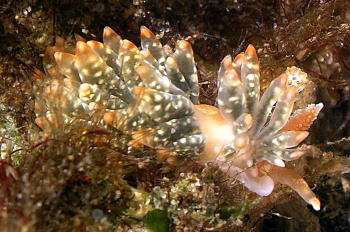
Dear Bill,
Here are some shots of another visitor to the river this year.I'm not sure but it looks a lot like Spurilla salaamica. I observed several under rocks in shallow water, always in pairs but failed to see any egg laying activity.
Other members of this family seen over the winter months were Spurilla australis and Spurilla major. Aeolidiella alba was very common, "shuffling" over rocks and also saw many specimens of what I think is Anteaeolidiella indica.
Locality: Brunswick River, New South Wales, Australia, Pacific. Depth: 2 metres, Length: 15mm, 4 July 2004. under rocks on river walls. Photographer: Denis Riek
Regards
Denis.
denisriek@hotmail.com
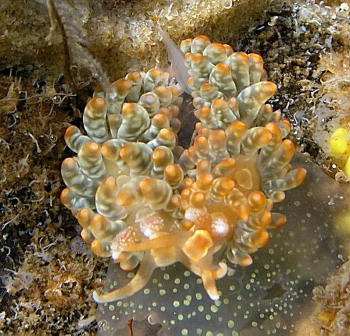
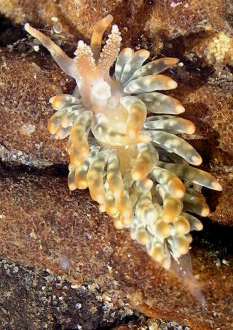
Dear Denis,
You certainly saw most of the regular aeolidiids you are likely to find in nthn New South Wales. I would like to see photos of them if you have them available. There is a possibility your animals here are Spurilla salaamica, but my feeling is that they are Spurilla major. Both species lack branching of the digestive gland in the dorsal skin of the body, but in S. major the rhinophores are quite short, as in your animal and there is a distinct set of white median colour patches, one on the anterior head and one over the heart, as you can see in your photos. The orange tinge is unusual,, but like the green colouration, I suspect its a result of the colours of the anemones they have been feeding on.
Best wishes,
Bill Rudman
Spurilla major from Indonesia
March 17, 2003
From: Takako Uno & Stephen Wong
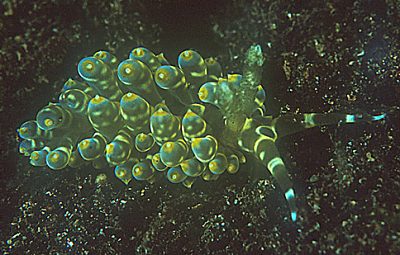
Dear Dr. Rudman,
Again, us. Can you kindly help us with the attached nudi, whether it is a Spurilla major or other kinds of Berghia?
I located it at Lembeh (where else) [Sulawesi, Indonesia] on the sand at about 13 meters. About 2.5 to 3cm and did not like headshots. Photo: Stephen Wong
Warmest wishes. Thanks again,
Takako and Stephen
divetoto@hotmail.com
Uno, T. & Wong, S., 2003 (Mar 17) Spurilla major from Indonesia. [Message in] Sea Slug Forum. Australian Museum, Sydney. Available from http://www.seaslugforum.net/find/9201Dear Takako and Stephen,
I am pretty sure this is Spurilla major. It ranges from animals with this bright colour pattern to very dull animals in which the blue and yellow pigment is only faintly visible
Best wishes,
Bill Rudman
Spurilla major from Queensland
September 17, 2000
From: Nerida Wilson
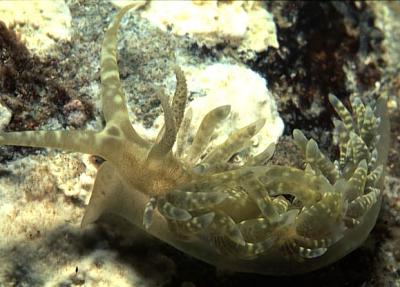
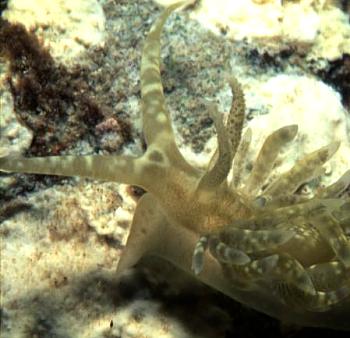
This nudibranch was collected in intertidal seagrass near Wynnum, Moreton Bay, Queensland, August 23, 2000 [Australia]. It looks a bit like other Austraeolis ornata that were collected in the same region, but the ceratal markings are a bit different, and it lacks the blue pigment that the others had.
What do you think?
Nerida Wilson
nwilson@zen.uq.edu.au
Wilson, N., 2000 (Sep 17) Spurilla major from Queensland. [Message in] Sea Slug Forum. Australian Museum, Sydney. Available from http://www.seaslugforum.net/find/3015Dear Nerida,
This is Spurilla major. You can say the tubercules on the rhinophores. If you look very carefully you can see the brown speckling through the skin, which is caused by the fine branches of the digestive gland packed with the single-celled plants (zooxanthellae) which it keeps alive in its tissues. Have a look at the Solar powered Sea Slug page for more background information.
This species probably feeds on sea anemones, and like many of its relatives, is able to break off its cerata very easily if disturbed.
Best wishes,
Bill Rudman.
Large Spurilla from Coffs Harbour, NSW
April 15, 2000
From: Carol Buchanan
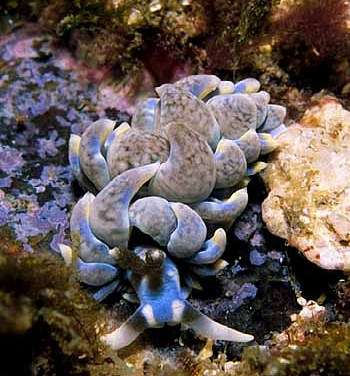
Hi Bill
Could you give me an ID on this animal please?
This Phyllodesmium? was the first attempt with a camera after 2 1/2 years being dry. It was photographed at South Solitary Island, off Coff's Harbour, northern New South Wales {Australia] at about 15 metres, and was approx 35mm long. There were 2 animals together, the second was much larger, too large to fit in my framers. Its hard to be more exact as to size, as the extension tube is a home made job, somewhere between 1:1 & 1:2.
Carol Buchanan
cbimages@turboweb.net.au
Buchanan, C., 2000 (Apr 15) Large Spurilla from Coffs Harbour, NSW. [Message in] Sea Slug Forum. Australian Museum, Sydney. Available from http://www.seaslugforum.net/find/2262Berghia/Spurilla major DSM
Dear Carol,
I am pretty sure this is a species of Spurilla rather than a Phyllodesmium, although it does have some similarities to Phyllodesmium magnum. I think I can see papillae on the rhinophores, which is a character of Spurilla, while in
I am pretty sure your animal is Spurilla major. Usually it is not so blue in colour but a photo in Willan & Coleman (1984) identified as Spurilla amakusana, but which is most probably S. major, has an intermediate colour pattern between your photo and the photos at the top of the page. The white bands on either side of the head are part of the white ring found on the head of less pigmented specimens. I have discussed the identity of this species more fully at the top of the page.
Best wishes,
Bill Rudman.
